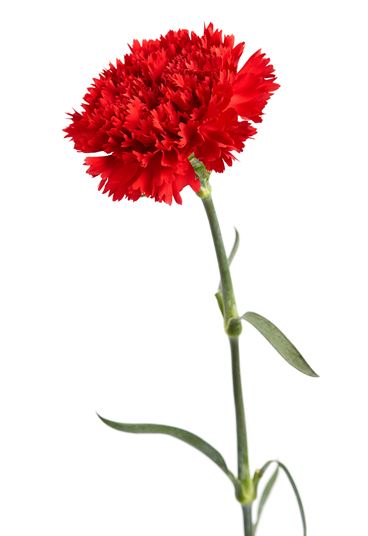
CARNATION
Dianthus caryophyllus
dy-AN-thus kay-ree-OFF-uh-lus
Description
This perennial herb is a perennial favorite and comes in an enormous array of cultivars. The classic large-blossomed varieties are double-flowering, with 2–3" (5–7.5 cm), softly-ruffled globes of up to 40 satiny, serrated petals. The strong, brittle, bluish-green stems grow 16–30" (0.40–0.76 m), and the narrow, pointed leaves are without ribs. Fragrance is usually mild and pleasant; cultivars with a stronger scent may have spicy notes reminiscent of cloves.
Standard and spray carnations are the two main types which are commercially grown for cut flowers. Standard carnations have one large bloom per stem; side buds are removed (disbudded) as the plant develops, in order to concentrate the plant’s energy into a producing single showy flower. The opposite approach is used for spray carnations: each stem has the terminal bud—which would usually develop into the largest blossom—removed, and the smaller side buds are allowed to grow as a cluster of blooms.
Many other Dianthus cultivars have been developed for planting in pots and borders, with familiar names like garden Dianthus, pinks and sweet Williams. Garden cultivars tend to be much smaller than florist carnations and include an abundance of simpler five-petaled single-flowering varieties, as well as miniature versions of the double-flowering florist carnations.
Colors: Pink, red, orange, yellow, green, purple and white, in solids as well as stripes. Blossoms also are easily dyed.
Special Care
Very sensitive to ethylene. Carnations should be pre-treated with anti-ethylene agents as soon as possible after cutting, by the grower or wholesaler. Ethylene exposure may cause shriveled blossoms, (“sleepiness”), browning petals, and arrested blooming in buds, so it’s important to verify with the supplier that they have received the proper pre-treatment.
Look for firm, half-open buds for standard carnations, and stems with three or fewer open buds for spray carnations. Stems are strong but snap easily, and calyx tend to split, so choose carefully.
Because carnations are so long-lasting, they may be packed and shipped dry. Treat dry-shipped carnations by recutting and hydrating for at least four hours at room temperature, in a warm solution 96°F (35°C) with a pH of 3.5. Additional anti-ethylene treatment should not be necessary if the flowers were pretreated by the grower.
Carnations may be stored at 34–36°F (1–2°C) at 90–95% humidity for up to four days. Protect stems against direct sunlight or heat, as they will damage the leaves.
Fun Facts:
Carnations are one of the top 5 bestselling florist flowers worldwide.
They’ve been a florist favorite for more than 300 years! They were first cultivated by the Moors in Spain in the 15th century, and first sold as a florist flower in Europe in the 17th century. (17th century florists! There’s a reality show waiting to happen…) By the 19th century, carnations were sold by florists all over the world.
In the United States, carnations have a special association with Mother’s Day. The holiday grew out of several grassroots efforts after the U.S. Civil War in the 1860s, but never really caught on until Miss Anna Jarvis—one determinedly sentimental woman—made it her personal crusade when her own mother died in 1905. She declared that white carnations were the only official flower for the day, because they were her mother’s favorites, causing both a boost and a nightmare for florists nationwide. Congress declared the holiday official in 1913, and carnations are still a favorite Mother’s Day flower more than a century later.
Carnations got their botanical name from Aristotle’s successor, the Greek “father of botany” Theophrastus. He combined the Greek word "dios" (meaning god) with "anthos" (meaning flower) to create the new word Dianthus, or “flower of the gods.”
The ancient Greeks honored heroes with living crowns, not just of laurel leaves, but carnation blossoms too. In fact, the name carnation may have its origin in the Latin word "corone"—which translates to crown.
Another possible origin of the flower’s name is from the Latin word "carnis" (meaning flesh), since the flowers are soft and pink, or "incarnacyon"—the Latin word for incarnation or made into flesh. This association led to many symbolic associations with Christianity.
During the Renaissance, when carnations’ popularity was growing, a connection was made between the carnations’ clove-like scent and the nail-like shape of dried cloves; and flowers’ soft colors and rounded blossoms became a symbol of the innocence of the Christ child. Renaissance paintings, which drip with hidden meanings and symbols, often show carnations as playthings or adornments for and around the infant Jesus.
According to one Christian legend, carnations first appeared on Earth at the crucifixion of Jesus, blooming instantly wherever the Virgin Mary’s tears fell along the path where Jesus dragged the cross.
Carnations were so popular among Victorians that they gave a special meaning not only to the flower itself, but gave each color variety its own significance.
The scarlet carnation is the state flower of Ohio.
Birth month flower for January.
First-wedding-anniversary flower.
National flower of the Balearic Islands, Sicily, Slovcenia and Spain.
Celebrity entrepreneur Paris Hilton thinks pink carnations and roses are hot.
Carnations do not grow naturally in Australia, but they are as popular and common there as in other parts of the world because they been grown as a florist flower there for more than 60 years.
One folk remedy calls for carnation petal to be brewed as a tea to relieve anxiety, fatigue or inflammation.
A member of the Caryophyllaceae family, carnations are related to sweet William, chickweed and baby’s breath.
Common Name
carnation
Botanical Name
Dianthus caryophyllus
Pronunciation
dy-AN-thus kay-ree-OFF-uh-lus
Origin

Seasonal availability
Vase Life
7 - 18 days, varying by cultivar. Spray carnations last longer than standard blooms.
Fragrant
Yes
Ethylene
Sensitive
Yes
Dryable
Yes
Language of Flowers Meaning
Carnations are used to symbolize love, distinction and devotion.